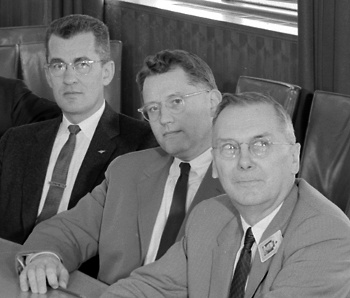H. Guyford Stever
May 18, 2011
I first attended
college at a small
trade school in the
New York State Capital District. Actually, it was an
engineering school, but at the time its engineering was taught more as a
trade than a
profession. I had the occasion to revisit there on business several years ago, and the place had improved considerably.
Guyford Stever, a prominent US
physicist, was a
trustee of that school while I attended. Stever died about a year ago, on April 9, 2010, at his home in a retirement community in
Gaithersburg, Maryland.
When I was in college, there was no internet, so I had no easy way of discovering who Stever was, or why he would consider being a trustee of that school. The apparent reason was that Stever was an
Upstate New Yorker, born in
Corning, New York. He attended
Colgate University, which is just thirty miles from
my hometown, graduating in 1938 with a B.S. in physics. I took one of my
SAT tests at Colgate when I was in high school, and I mentioned one of its seminar series in a
previous article (The Birthday Problem, August 4, 2010).
There are two significant stories about Stever's undergraduate experience. He needed a suit before going off to college, so friends and neighbors in Corning bought it for him.[1] His son, Roy, said that he was treated like a second-class citizen while at Colgate, since he was attending on a
scholarship.[1] The rural boy was out of place with the
second-tier Ivies.
Horton Guyford Stever, who was known as "Guy" by his friends and associates, was born on October 24, 1916. He was orphaned as a young child and was raised principally by his maternal grandmother. After Colgate, Stever obtained his Ph.D. in physics in 1941 from
Cal Tech. His Ph.D. dissertation, under the direction of
William Pickering, was on
cosmic rays and the lifetime of the
meson.[2] After his degree, he joined the
MIT Radiation Laboratory, where "radiation" referred to
radar signals and not
nuclear radiation, but he spent most of
World War II as a civilian scientific liaison officer to
British scientists in
London.
Stever was one of the US scientists who examined
German technology in
Europe at war's end. In her obituary of Stever in
Physics Today, Sheila E. Widnall of MIT retells an anecdote of Stever's war experience. When Stever and his colleagues were searching for areas of interest, they arrived at a German radar site that was still manned by German troops. The Germans surrendered to the scientists.[2]

Stever at the May 26, 1958, meeting of the NACA Special Committee on Space Technology.
Stever (center) is flanked by Carl B. Palmer (left), Secretary to the Committee, NACA Headquarters, and Hugh L. Dryden (right) ex officio Director of NACA.
(Via Wikimedia Commons)
Stever was associate dean of engineering at MIT from 1956–1959, taking a short leave in 1956 to serve as chief scientist of the
US Air Force. He then served as a department head for
mechanical engineering through 1965, when he was named president of the
Carnegie Institute of Technology. Stever facilitated the creation of a
computer science department at Carnegie Tech in 1966. It was one of the first two such departments created in the US.[1]
Carnegie Tech merged with the
Mellon Institute of Industrial Research under his leadership to become
Carnegie Mellon University, and he served as its president until 1972. Stever was Director of the
National Science Foundation (1972 - 1976), succeeding the
biochemist,
William D. McElroy. Stever also served as
US President Gerald Ford's Science Advisor (1973 - 1977).
It's no surprise that Stever was a member of several U.S. government advisory committees, the most significant was his chairmanship of the
National Advisory Committee for Aeronautics Special Committee on Space Technology. This committee, known as the "Stever Committee," was organized to coordinate a US response to the
Soviet space program. He chaired a
National Research Council committee that examined the
1986 Challenger accident and developed a redesign of the
space shuttle booster rocket. Well into his 70s, Stever chaired a 1990 National Research Council Committee on
Human Exploration of Space.
What is most interesting to me is that Stever, a physicist, spent most of his career among engineers. His administrative skills were facilitated by his easy personality. His son, Roy, commented that "...he was such a remarkably comfortable person to be with."[1] CMU honored Stever in 2008 by naming Stever House, its first "
green" residence hall, after him.[1] One of his two sons is named Horton Guyford Stever, Jr.
References:
- Eleanor Chute, "Obituary: Horton Guyford Stever - President who merged Carnegie, Mellon institutes," Pittsburgh Post-Gazette, April 11, 2010
- Sheila E. Widnall, "Obituary: Horton Guyford Stever," Physics Today, vol. 64, no. 3 (March, 2011), pp. 71-72.
- Jared L. Cohon, CMU President, "Remembering President Stever," Announcement of the death of H. Guyford Stever, April 4, 2010.
- Guyford Stever page on Wikipedia.
Permanent Link to this article
Linked Keywords: College; trade school; New York State; Capital District; engineering; trade; profession; Guyford Stever; physicist; trustee; Gaithersburg, Maryland; Upstate New York; Corning, New York; Colgate University; Utica, New York; SAT test; scholarship; Hidden Ivies; Cal Tech; William Pickering; cosmic rays; meson; Massachusetts Institute of Technology; MIT; Radiation Laboratory; radar; radioactive decay; nuclear radiation; World War II; British scientists; London; Germany; Europe; Physics Today; Wikimedia Commons; US Air Force; mechanical engineering; Carnegie Institute of Technology; computer science; Mellon Institute of Industrial Research; Carnegie Mellon University; National Science Foundation; biochemist; William D. McElroy; US President Gerald Ford; National Advisory Committee for Aeronautics; Special Committee on Space Technology; Soviet space program; National Research Council; 1986 Challenger accident; space shuttle; booster rocket; Human Exploration of Space; green building.